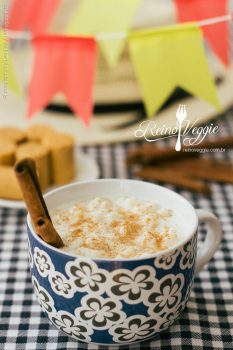Brazilian recipes – Canjica Posted by carol on May 31, 2018 in Brazilian Profile, Culture, Customs, Entertainment, Learning, Vocabulary
Olá a todos! Hello, everybody! Como estão hoje? How are you today?
Today is the last day of maio (May), we barely made it halfway through the ano (year) and a lot has taken place, as we have discussed in our previous post about the trucker’s strike. And there is still a lot to come: the Copa do Mundo (World Cup) in Russia is bound to stop not only soccer fans, but the whole country, and the presidential elections in outubro (October) are likely to generate plenty of conflict among us.
But there are still reasons to celebrate, after all, amanhã (tomorrow) is the beginning of junho (June) and at least one thing is certain: festas juninas are going to take over Brazil. The ubiquitous festivity is a great event to find solace from the clima frio (cold weather) and treat ourselves to some delicious comida típica (typical food).
We have plenty of material about it here, so check out these previous posts on the topic so you can learn even more about festa junina!:
But today our focus is going to be a one-of-a-kind mandatory festa junina dish that warms our hearts: the canjica.
It is a doce (sweet) dish widely consumed over this festival season and it consists of a kind of porridge made with specific kernels, a type of white milho (corn) available in any supermarket. We can use both condensed milk or coconut milk as a basis for the receita (recipe), so I have selected one that combines both so it adds even more to the sabor (flavor). No matter if you are in Brazil right now or somewhere else, this is a recipe worth trying anywhere! So take a look below for what you’ll need and the instructions on how to do it!
Receita de Canjica | Canjica recipe
INGREDIENTES | INGREDIENTS
500 g de milho para canjica | 500 g of canjica corn
500 g de amendoim torrado| 500 g roasted peanuts
1 lata de leite condensado | 1 can of condensed milk
250 g de côco ralado | 250 g grated coconut
1 litro de leite | 1 liter of milk
500ml de leite de coco | 500ml of coconut milk
1 colher (café) de canela em pó | 1 teaspoon ground cinnamon
1 xícara (chá) de açúcar | 1 cup sugar
Cravo a gosto | Clove to taste
MODO DE PREPARO | STEPS
- Deixe a canjica de molho de um dia para o outro | Leave the canjica soaking overnight
- Depois, escorra a água e coloque a canjica numa panela de pressão, cubra totalmente com água (4 cm acima da canjica) | Then, drain the water and place the canjica in a pressure cooker, cover with water (4 cm above the canjica)
- Adicione o cravo, a canela em pau e açúcar | Add the clove, the cinnamon and sugar
- Leve ao fogo médio e deixe por 30 minutos na pressão | Bring to medium heat and leave for 30 minutes on pressure
- Enquanto isso moa no liquidificador o amendoim (torrado) com o leite, juntando depois, aos poucos o côco ralado | Meanwhile, blend the peanut with the milk, then slowly add the grated coconut to a blender
- Junte os demais ingredientes e bata para obter uma mistura homogênea | Add the remaining ingredients and beat to obtain a homogeneous mixture
- Apague o fogo, retire a canjica da panela pressão | Turn off the heat, remove the canjica from the pressure cooker
- Adicione o conteúdo do liquidificador e a canjica em uma panela | Add the contents from the blender and the canjica in a pan
- Ferva e em fogo baixo até reduzir o líquido pela metade e a canjica ficar cremosa (por volta de 10 minutos) |Boil on low heat until the liquid is reduced in half and the canjica is creamy (about 10 minutes)
- Apague o fogo e sirva | Put out the fire and serve
- Bom apetite!
Espero que gostem! Hope you guys like it!

Build vocabulary, practice pronunciation, and more with Transparent Language Online. Available anytime, anywhere, on any device.




